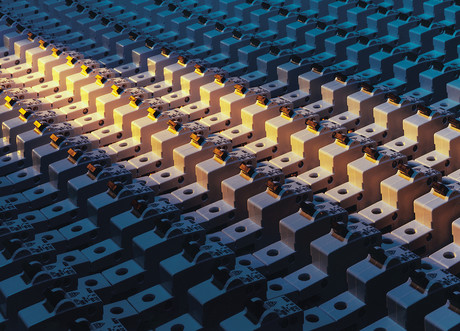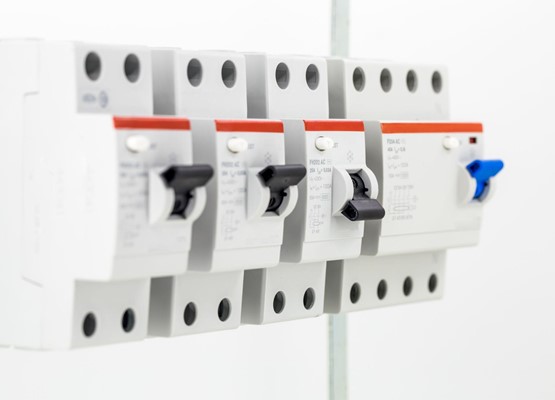Installing MCBs in your solar panel setup ensures enhanced safety by preventing overcurrents, boosts system reliability, cuts maintenance costs by 30%, complies with regulations, and extends component lifespan by 20%.
Enhanced Safety
Defense Against Overcurrent
If you have your solar panels set up, think of it as running all the large electronics in your house. The reasons for a sudden increase in power could be perhaps due to either the short circuit or an unplanned fault. MCBs: Another important safety feature when you install solar panels is installing MCBs(Miniature Circuit Breakers). They can turn off power when an overload of current is detected, to prevent risking damage your equipment and also reducing the risk of electrical fires.
How To Avoid Electrical Fires
The National Fire Protection Association warns that overheating wires or connections can cause electrical fires. MCBs are made to identify any discrepancies in the current flow and cut off the circuit before wires start melting. It minimizes the risk if ever there are electrical fires starting in your solar panel system.
Quality Standards & Peace of Mind
There are many kinds of MCBs available, which caters to various spacing and specifications to suit your solar panel setup. The different level of electrical loads can be categorised into Type B, type C and type D. Type B MCBs, which trip at 3-5 times the rated current are typically all that is needed for residential solar installations. Opting for MCBs that adhere to standards like IEC 60898 or UL 1077 ensures your installation is protected by robust components!
Easy to integrate and User-Friendly
The process of integrating MCBs with a solar panel system, is simple and user-friendly. Made for simple mounting to DIN rail and/or quickly wired into your existing system. Being simple, they are suitable for upcoming installations and also retrofitting the present systems. Moreover, MCBs are very practical as well because in case if any of them trips you can just turn it back on after fixing the problem instead of replacing a fuse.

Improved System Reliability
Minimizing Downtime
For example: Imagine your solar panel system, which has been working just fine all along suddenly develops a fault and no longer supplies you enough power for hours. MCBs (Miniature Circuit Breaker) greatly helps in reducing such downtime. They quickly pinpoint and separate the causes of failure within a system, thereby keeping other parts operational. If only one panel in your array develops a fault, the MCB trips for that particular panel alone - guaranteeing the remainder of your array is still able to function.
Consistent Power Supply
Molded Case Circuit Breaker offers having an uninterrupted way to get the power are one of its huge benefits in terms using it with solar solution. For an MCB in a standard house solar system, they typically range from 6A to 32A depending on your installation needs. Those are the devices that keep small problems from escalating into system-eating messes, and make sure your light stays on.
Simplified Fault Detection
MCBs are made in a way that it can easily detect faults. If an MCB has tripped, it means the particular circuit which faced a problem. So it specifies quickly which component caused the problem helping in reducing diagnosis time. In the case of a solar system with two many circuits, if an MCB trips you will immediately know and can rectify the problem quickly so that it won't take as long to come back online.
Different types of MCB for Solar Systems
Various mounting methods of MCBs exist for different applications in a solar panel setting. Generally in residential installations Type B MCBs which trip between 3-5 times the rated current are used. Type C or Type D MCBs could be the better choice for commercial / industrial solar installations, since they have higher tripping thresholds (5-10 times and 10-20x rated current) respectively. Picking the best version of MCB can guarantee an efficient as well reliable at your end to satisfy operational requirements.
Long-Term Reliability
While the upfront costs may be more significant, investing in premium MCBs plays a role in ensuring your solar panel system lasts well into the future. Quality MCBs meeting reference standards like IEC 60898 or UL 1077, will offer solid protection and perform consistently over the course of their rated life. This translates to fewer replacements and repairs over time for a more secure long term solar power system.
Cost-Effective Maintenance
Easy Fault Identification
One of the most significant challenges in maintaining a solar panel setup is identifying faults without delay and quickly. MCBs (Miniature Circuit Breakers) simplifies this process by promptly telling you which individual circuit is at fault when tripping occurs. You wake up one morning with reduced solar output. Rather than spending hours over checking each part, a tripped MCB will tell you the exact circuit at fault thereby saving time and labour.
Simplified Repair Process
MCBs simplify the process of repair as soon as a fault is identified. Quick and easy to reset (After you fix the fault, just flip on that MCB again) This consumer-friendly function negates the necessity alternate fuses and do complex rewiring seems to fall between performing repairs, reducing the time and price of savings.
Lower Replacement Costs
MCBs tend to be more durable with a longer lifespan and so can significantly reduce replacement costs over the lifetime of an installation. Good MCBs will last for tens of thousands, and are unlikely to wear out. A MCB with 10,000 operations could potentially survive for years in a fairly common small residential solar application, even if it trips so much due to little things.
Common MCB Specifications
You should choose MCBs that are both cost-effective as well match the specifications required by your solar setup. Common ratings in residential systems are 6A, 10A,16A,and32 A. The correct rating is important for the MCB to be able to handle the expected on load without unwanted tripping or even damage. Ask the output MCB rating of 16A that is appropriate for a typical solar circuit in normal cases, but you might need it higher at times like when your power requirement is larger and asks more than just that.
Compliance with Regulations
Meeting Electrical Standards
It is important that the construction & installation of Solar Panels follows national and international power standards. By installing MCBs (Miniature Circuit Breakers), the system is in line to follow these laws, preventing legal problems and improving safety. Many countries strictly follow the International Electrotechnical Commission (IEC) standards More specifically IEC 60898 for MCBs, which sets out performance requirements of a typical installation.
Insurance Requirements
Solar panel owners might have to comply with some safety standards if they want insurance companies to offer them coverage. MCBs play a vital role in meeting these criteria. Overcurrent protection - as many insurance policies covering electrical systems often require.
Local Building Codes
Most local codes will require some form of overcurrent protection like an MCB in solar installations. These are codes that have been implemented in order to protect the safety and preservation of electrical systems within both homes, businesses and corporations. As an example, a city ordinance may mandate that for any solar installation beyond a given capacity must employ MCBs.
Types of MCBs for Compliance
MCBs are provided in Type B, Type C or D forms-appropriate for different applications. Type B MCBs - normally used in residential environments and manufactured with a tripping current of 3-5 times the rated value. For commercial applications Type C MCBs, trips at 5-10 times the rated current are designed to be used. This difference helps in choosing the right MCB that complies with regulatory requirements.
Inspection and Certification
In addition to this, checks and certifications at regular intervals form an integral part of the ensuring that those operating in accordance with regulations. MCBs MCBs simplify the testing itself, as they offer visibility to status and safeguarding stages. In case of a searching an MCB, on the other hand as it will immediately trip and indicates to have a fault - which helps for easy troubleshooting during inspection.

Longevity of solar equipment is increased.
Reducing Wear and Tear
MCBs (Miniature Circuit Breakers) -Graphic Presentation Integraintegrated ing MCBs into your solar panel system can lead to much less wreck on electrical components. They are more prone to being shortcircuited, and MCBs act as the defenders of your solar panels, inverters, or wiring against overcurrents. An MCB can trip during a lightning storm and isolation the surge from reaching the sensitive equipment. By doing this you protect your components and therefore extend their life expectancy.
Prolonging Equipment Life
Solar components longevity (panels, and inverters) is directly proportional to the electrical environment in which they operate. MCBs help create an even electric space around panels leading to no fluctuation or overloading issues; else it will degrade due course of time sooner. While it is common for solar panels to last 25-30 years, if you are regularly experiencing electrical problems your lifespan might be less than this.
Common MCB Ratings
Choosing the Right MCB Rating for Your Solar Panel Setup is Vital to Get The Best Protection. MCBs are usually 6A to 32A for domestic solar installations, These ratings are there to ensure that each of the MCB is able to withstand loads which a typical household may draw at any point without false tripping. Larger commercial installations may require MCBs rated at 63A or even 100A.
Preventing Overheating
Preventing overheating of electrical components is one such critical function provided by MCBs. One of the more common reasons for solar panels and inverters to become faulty is due to overheating. An electrical fault such as short-circuiting can lead to high current flow that generates a lot of heat, destroying the components.
